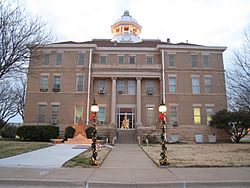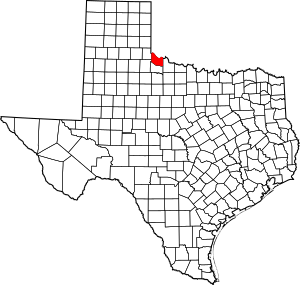Hardeman County, Texas facts for kids
Quick facts for kids
Hardeman County
|
|
|---|---|

The Hardeman County Courthouse in Quanah
|
|

Location within the U.S. state of Texas
|
|
 Texas's location within the U.S. |
|
| Country | |
| State | |
| Founded | 1884 |
| Seat | Quanah |
| Largest city | Quanah |
| Area | |
| • Total | 697 sq mi (1,810 km2) |
| • Land | 695 sq mi (1,800 km2) |
| • Water | 1.8 sq mi (5 km2) 0.3% |
| Population
(2020)
|
|
| • Total | 3,549 |
| • Density | 5.092/sq mi (1.9660/km2) |
| Time zone | UTC−6 (Central) |
| • Summer (DST) | UTC−5 (CDT) |
| Congressional district | 13th |
Hardeman County (/ˈhɑːrdɪmən/ HAR-di-mən) is a county located in the U.S. state of Texas. A county is like a smaller region within a state. In 2020, about 3,549 people lived there.
The main town and government center of the county is Quanah. It is also the largest city. Hardeman County was officially created in 1858 and started its government in 1884. It is named after two brothers, Bailey Hardeman and Thomas Jones Hardeman. They were important leaders and lawmakers in early Texas. For a long time, until 2006, Hardeman County was a "dry county." This meant that selling alcohol was not allowed. But in November 2006, people voted to allow alcohol sales again.
Contents
Exploring Hardeman County's Geography
Hardeman County is in the northern part of Texas. It covers a total area of about 697 square miles. Most of this area, 695 square miles, is land. Only a small part, about 1.8 square miles, is water.
The Prairie Dog Town Fork Red River flows through the county. It joins with Buck Creek in the northwest to form the Red River. This river then flows east and forms the northern border of the county, separating Texas from Oklahoma. Hardeman County is the northernmost county in Texas that is not part of the Texas Panhandle.
Main Roads in Hardeman County
You can travel through Hardeman County using these important highways:
Neighboring Counties and States
Hardeman County shares its borders with several other counties:
- To the north: Harmon County, Oklahoma and Jackson County, Oklahoma (both in Oklahoma)
- To the east: Wilbarger County
- To the south: Foard County
- To the southwest: Cottle County
- To the west: Childress County
Understanding Hardeman County's Population
The number of people living in Hardeman County has changed over the years. Here's how the population has grown and shrunk:
| Historical population | |||
|---|---|---|---|
| Census | Pop. | %± | |
| 1880 | 50 | — | |
| 1890 | 3,904 | 7,708.0% | |
| 1900 | 3,634 | −6.9% | |
| 1910 | 11,213 | 208.6% | |
| 1920 | 12,487 | 11.4% | |
| 1930 | 14,532 | 16.4% | |
| 1940 | 11,073 | −23.8% | |
| 1950 | 10,212 | −7.8% | |
| 1960 | 8,275 | −19.0% | |
| 1970 | 6,795 | −17.9% | |
| 1980 | 6,368 | −6.3% | |
| 1990 | 5,283 | −17.0% | |
| 2000 | 4,724 | −10.6% | |
| 2010 | 4,139 | −12.4% | |
| 2020 | 3,549 | −14.3% | |
| U.S. Decennial Census 1850–2010 2010 2020 |
|||
In 2000, there were 4,724 people living in Hardeman County. About 29.9% of households had children under 18. The average age of people in the county was 41 years old.
Economy and Jobs in Hardeman County
One important business in Hardeman County is Georgia-Pacific. They have a factory that makes gypsum products in a small community called Acme. This plant is about 6 miles west of Quanah, along U.S. Highway 287.
Fun Places to Visit in Hardeman County
Hardeman County offers some interesting places to explore:
- Copper Breaks State Park: This park is run by the Texas Parks and Wildlife Department. It is located in the southern part of the county, near the Pease River. You can find it off State Highway 6, about 12 miles south of Quanah. The park is home to some of the state's famous Texas Longhorn cattle.
- Lake Pauline: This lake is located off U.S. Highway 287, about 6 miles east of Quanah. It's a great spot for outdoor activities.
Towns and Communities
Hardeman County has a few towns and communities:
Cities
- Chillicothe
- Quanah (This is the county seat, where the main government offices are)
Small Communities
- Goodlett
Historic Ghost Towns
Some places that used to be towns are now "ghost towns" because most people have moved away:
Learning and Education
Students in Hardeman County attend schools in different districts:
- Childress Independent School District
- Chillicothe Independent School District
- Quanah Independent School District
For higher education, the county is served by Vernon College.
See also
 In Spanish: Condado de Hardeman (Texas) para niños
In Spanish: Condado de Hardeman (Texas) para niños

